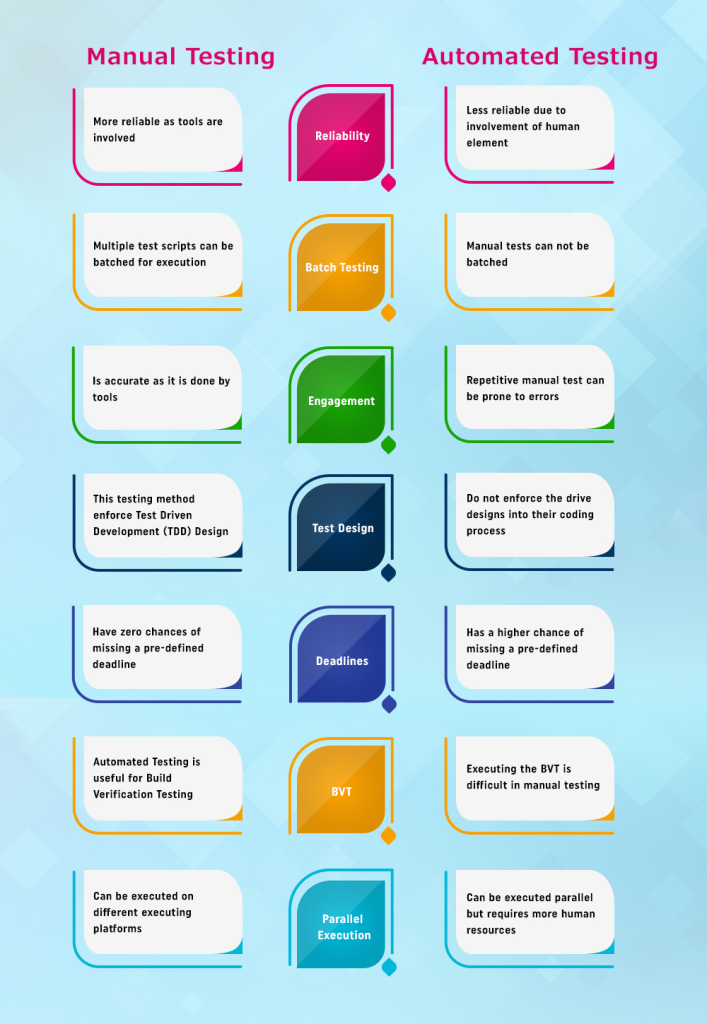
Within the dynamic realm of software development, automation frequently garners acclaim as the ultimate solution for streamlined testing. Nonetheless, it is incumbent upon us to acknowledge the timeless merits of manual testing. Administered by adept human testers, manual testing presents an exceptional array of advantages that harmonize with automated testing, ultimately contributing to the realization of a resilient and top-tier software product. In this blog, we shall explore the merits of manual testing within the domain of software quality assurance.
- Exploratory Testing: Manual testing offers an invaluable advantage in the form of exploratory testing. This method is characterized by its unscripted, dynamic nature, allowing testers to navigate the software in an unrestrained manner, unearthing intricacies that might elude automated scripts. Human testers excel in emulating real-world usage scenarios, rendering exploratory testing particularly adept at uncovering usability, design, and functionality issues that automated testing may overlook.
- Real-World Scenarios: Manual testing empowers testers to leverage their experience and intuition to simulate real-world scenarios akin to those faced by end-users. This human perspective plays a pivotal role in pinpointing issues arising from distinctive user interactions, unconventional combinations of actions, or ambiguous situations, all of which can pose challenges beyond the scope of automated testing.
- Adapting to Changes: In the ever-evolving landscape of software development, manual testing emerges as a beacon of adaptability, adept at accommodating shifting requirements and frequent updates. Human testers exhibit the agility to swiftly adjust test cases, evaluate fresh functionalities, and validate eleventh-hour alterations, thus guaranteeing the software’s continued reliability and currency.
- User Experience Evaluation: User experience stands as a pivotal dimension of software quality. Manual testers offer a wellspring of insights into the aesthetics, functionality, and user-friendliness of an application. Their feedback wields the power to profoundly influence software design and usability, ultimately culminating in an enhanced user experience.
- Unbiased Testing: Manual testing paves the way for impartial and subjective evaluation of software. Testers inject a new and unbiased viewpoint into the product, offering unique value in the detection of issues tied to accessibility, diversity, and inclusivity.
- Early Detection of User Interface Issues: Automated tests may inadvertently overlook nuanced user interface intricacies, such as layout irregularities, color contrast disparities, or alignment issues. Manual testing steps in to meticulously detect these concerns during the early stages of development, contributing to the creation of a visually captivating and user-friendly product.
- Test Case Creativity: Manual testers possess the ability to craft imaginative test cases that unveil concealed defects. They engage in inventive explorations with diverse inputs, experiment with unconventional scenarios, and utilize their problem-solving acumen to unearth issues that automated scripts might inadvertently bypass.
- Uncovering Regression Issues: Manual testing performs an essential function in pinpointing regression issues post-code changes or updates. Testers take on the responsibility of confirming that new developments do not detrimentally impact pre-existing functionalities, thereby upholding the overall integrity of the software.
- Complex and Niche Testing: Some testing categories, including security, performance, and compatibility testing, often demand specialized knowledge and skills. Manual testers can be specialists in these domains and are better prepared to detect and resolve intricate issues.
- Cost-Effective for Small Projects: Smaller software projects or startups with constrained resources might find manual testing to be a cost-effective solution. Automated testing tools demand an initial investment in terms of time and money, which may not be feasible for every project.
Conclusion
Automated testing brings efficiency and consistency to software quality assurance, but manual testing remains a fundamental element of a holistic testing strategy. The advantages of manual testing, including exploratory testing, real-world scenario evaluation, and user experience assessment, are indispensable for ensuring that software products excel in functionality and user-friendliness. The harmonious integration of manual and automated testing is paramount in delivering software that meets or exceeds user expectations.
Digital Marketing Manager at Cotocus